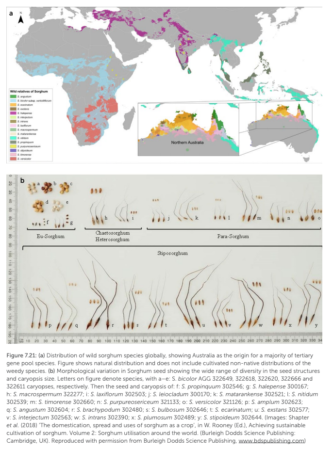- Conservation needs to break free from global priority mapping. Couldn’t agree more. And less.
- National climate and biodiversity strategies are hamstrung by a lack of maps. Wait, what?
- The evolutionary genomics of species’ responses to climate change. You need to combine niche modelling with genetic adaptation to get the best maps.
- Payoffs to a half century of CGIAR research. A benefit-to-cost ratio (BCR) of 10:1. Not counting the genebanks. And all the maps.
- A case for conserving plant pathogens. But will it be worth it?
- Poor data stewardship will hinder global genetic diversity surveillance. What’s the BCR for decent metadata?
- Mitigating tradeoffs in plant breeding. Cutting out the cross-talk changes tradeoff to payoff.
- Comparing Productivity of Organic and Conventional Farming Systems: A Quantitative Review. Conventional is more productive. But should yield be the only criterion?
- Priority micronutrient density in foods. Right. Micronutrients are also important.
- Reconciling yield gains in agronomic trials with returns under African smallholder conditions. And how was yield measured anyway?
- Data-driven, participatory characterization of traditional farmer varieties discloses teff (Eragrostis tef) adaptive and breeding potential under current and future climates. This might well be an example of applying the lessons of the above.
- Genetic Diversity and Utilization of Cultivated Eggplant Germplasm in Varietal Improvement. The wild relatives will save us.
- Quinoa Phenotyping Methodologies: An International Consensus. But will it work for the wild relatives? Just kidding, this is an important development for another crop (with the above) which doesn’t have something like the CGIAR and its 10:1 BCR behind it…
Nibbles: Luxury brands, Food companies, TV and diets, Saving seeds, IUCN Green Status, 0 Hunger Pledge, Zizania
- Luxury brands discover biodiversity: “There is no champagne without grapes, no ready-to-wear without silk and cotton, no perfume without flowers…”
- What about global food and agriculture companies though? Let’s find out, shall we?
- TV can help where companies won’t.
- Of course, you can set up your own company, as these Tunisian women did.
- Imagine a company helping to move a species to “green status.” Imagine.
- They could sign the Zero Hunger Pledge for the Private Sector while they’re at it.
- But meanwhile, on Ojibwe land…
How to genebank, and why
The third edition of “Strategies and guidelines for developing, managing and utilising ex situ collections” from the Australian Network for Plant Conservation is out and it’s nothing short of monumental. Here’s the contents.
Chapter 1: Introduction.
Chapter 2: Options, major considerations and preparation for plant germplasm conservation.
Chapter 3: Genetic guidelines for acquiring and maintaining collections for ex situ conservation.
Chapter 4: Seed and vegetative material collection.
Chapter 5: Seed banking: orthodox seeds.
Chapter 6: Identifying and conserving non-orthodox seeds.
Chapter 7: Seed germination and dormancy.
Chapter 8: The role of the plant nursery in ex situ conservation.
Chapter 9: Tissue culture.
Chapter 10: Cryopreservation.
Chapter 11: Living plant collections.
Chapter 12: Isolation, propagation and storage of orchid mycorrhiza and legume rhizobia.
Chapter 13: Special collections and under-represented taxa in Australasian ex situ conservation programs.
Chapter 14: Risk management and preparing for crises.
Chapter 15: Maintenance, utilisation and information storage.
There are also 50 case studies, focusing on Australian examples, including this on sorghum wild relatives.

And, given the news about the threats to crop wild relatives and trees, it’s all just as well.
Nibbles: Genebanks in Brazil, Tunisia, Ghana, Ethiopia, Goan rice, Wheat adoption, Peruvian hot peppers & cacao, Amazonian fruits and nuts, Dates, Great Hedge of India, Conservation genetics presentation
- Safety duplicating a chickpea collection.
- Tunisia’s genebank in the news.
- Ghana’s genebank trying to save taro.
- Using a genebank to improve Elephant grass.
- On-farm conservation of rice in Goa.
- Molecular tools show that a couple of varieties account for about half the wheat acreage in Bangladesh and Nepal. Hope all the landraces are in genebanks, and safety duplicated.
- Celebrating Peruvian pepper diversity.
- Peru’s cacao diversity doesn’t need help, apparently.
- However, the Amazon’s wild-extracted fruits (including cacao and a wild relative) could be in trouble. Hope they’re in genebanks, just in case.
- How the date came to the US. Including its genebanks.
- India had a precursor of the Green Wall of Africa but nobody remembers it. Glad it wasn’t used as a genebank of sorts.
- Conservation genetics (i.e., most of the above) explained in 48 slides.
Nibbles: Eat This Newsletter, Basmati, DSI, NBPGR collecting, Ganja page
- Jeremy’s latest newsletter covers in more depth things we just Nibbled here, including perry and ancient bananas, plus much other stuff. We talked about “wild rice” here a couple of times.
- As for actual rice, the controversy between India and Pakistan about the origin of Basmati just got a bit more complicated. Could it in fact have come from Afghanistan?
- Maybe everyone should listen to Dr Amber Scholz’s ideas about ABS.
- Meanwhile, India’s National Bureau of Plant Genetic Resources regional centre in Kumaon has been busy collecting germplasm. No word on whether that includes rice, Basmati or otherwise.
- Pretty cool way of presenting accession data, courtesy of Mystery Haze. I wonder where that’s from originally.